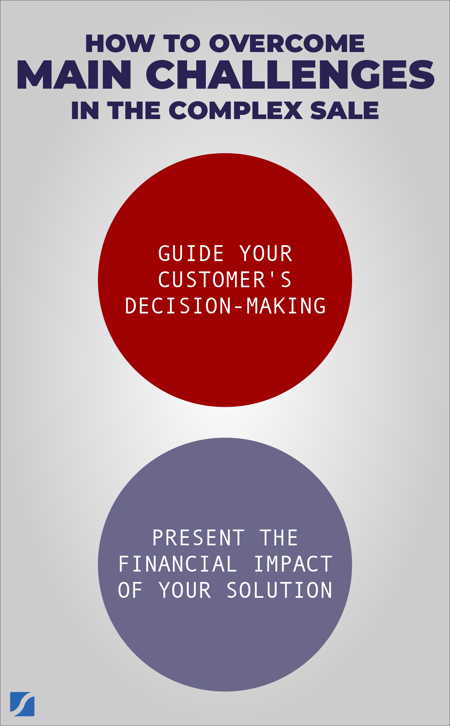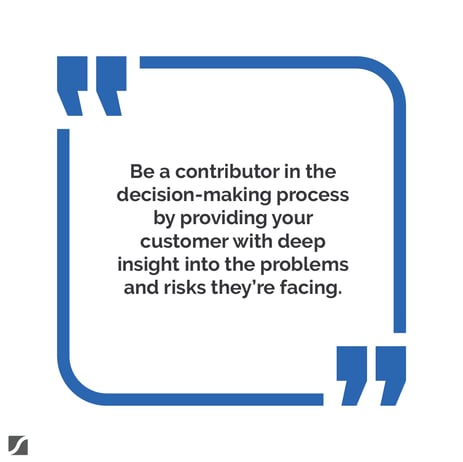2 Key Strategies To Help You Navigate Today’s Complex Sales Market

As a business leader managing sales, you’re probably doing most things right. You’re creating high-value, competitive solutions that offer many sources of value for an organization. You’re presenting outstanding services to help your customers implement and succeed with those solutions.
But that’s where the trouble starts.
All this value and all these areas of impact make the purchasing decision complex, like figuring out a single traffic sign that displays multiple sets of stop lights.
When making a complex sale, if you focus only on presenting and managing solutions, you’re assuming that your customer already understands their problem. But, for many customers, that’s simply not the case.
As president and CEO of Prime Resource Group, I’ve helped companies like Shell, HP, Honeywell, and 3M develop their business strategies. I’ve written books about high-stakes sales, including Mastering The Complex Sale.
And I’ve noticed something that CSO Insights, which produces annual reports on sales enablement, has revealed as well: More and more sales are being lost not only to competition—but also to the customer’s lack of a decision. In 2008 CSO Insights’ global research revealed that 49% of sales outcomes were wins, 30% were competitive losses, and 21% ended with no decision by the customer.
By 2019, 32% of sales yielded wins, 34% were competitive losses, and 44% resulted in no decision. There’s plenty of talk now that the “no decision” figure these days is closer to 50%.
That’s about half of sales that are left on the table because the customer couldn’t figure out what to do. Instead of buying—from you or anyone else—they stuck with the status quo.
Are you ready to shift those “no decisions” to sales wins? Start by identifying:
- 3 key challenges of the complex sale
- 2 big strategies to overcome complex sales challenges
3 Challenges Of The Complex Sale
Sales professionals are trained to describe a solution, not serve as a contributor who helps identify a problem. You know to tell a customer how your product or service works and what it’s done for other people.
But the customer needs something else from you first.
The customer needs guidance to help them understand their problem. But there are obstacles you need to overcome to make the problem clear—and then show how your solution resolves it.
The following are the 3 main challenges of the complex sale.
Challenge 1: Decision
If you’re thinking about professions to emulate for providing guidance to customers, consider certified public accountants (CPAs), attorneys, engineers, or architects. Their work has one thing in common: It starts with guiding clients through an organized, thorough, cross-functional, and objective decision process.
To what degree are you and your sales team providing guidance to your customers, helping them make a decision in a quality, informed fashion?
Challenge 2: Change
When you’re guiding the customer’s decision, you’re not guiding a decision to buy. You’re helping them make a decision to change.
It’s only after a customer decides whether to change that they decide what to buy to facilitate that change. But change is painful. I believe that most of the customers who fall under the “no decision” umbrella mentioned earlier do so because they never decided to change.
Are you ensuring that your solutions are relevant to the customer by first showing them why they need to change?
Challenge 3: Value
A customer must recognize what it costs to not have your solution and what they might get back if they make the change. And they must be able to measure that value.
Are you and your team equipped to help customers understand—in quantifiable terms—the net profit that’s at risk if they remain in their current situation?
2 Strategies For Overcoming Complex Sales Challenges
Now that your complex sales roadblocks are clear, what strategies can you employ to overcome them? How do you assist customers in decision-making, encourage them to make a change, and show them your solution’s value?
The following 2 strategies can help you blast through the biggest complex sales barriers.
Strategy 1: Guide Your Customer’s Decision-Making
Become the advisor your customers are seeking by considering the key milestones in their decision-making process, recognizing the limits to their understanding of the problem, and identifying the signs that they’re ready to buy.
Milestones Of A Business Decision
While there are a dozen or more milestone questions a customer considers when making a decision, the following are some of the biggest:
- Are our profits at risk?
- Should we invest resources to measure the risk?
- What is the level of financial risk impact?
- Does the level of financial risk warrant action?
- What is the desired outcome?
- Can that outcome be achieved?
Help customers work through these milestones, paying particular attention to Number 4. You will know the customer is taking your proposed solutions seriously when they can answer yes to “Does the level of financial risk warrant action?”
Understanding Of Business Problems
Customers typically bring to the table 24% comprehension of the problem and solution. That means if you lead by offering a solution, the customer will understand about 24% of what you’re describing—and probably will be willing to pay about 24% of your price.
Be a contributor in the decision-making process by providing your customer with deep insight into the problems and risks they’re facing.
Behaviors In The Decision-Making Process
The decision-making process includes distinct phases and behaviors that progress through the customer’s willingness to make a change. These steps represent the diagnostic phase of the complex sale.
Listed from low probability of change to high probability of change, the phases and their behaviors are:
- Satisfied
The customer sees no problem and likely will be defensive about any proposed change. - Neutral
They are comfortable and not expressing interest in taking action. - Aware
They recognize this problem is happening to others like them. - Concern
They understand the problem is happening to them but aren’t sure about its impact. - Critical
They’re learning about the problem’s cost to their company. - Crisis
They realize the scope of the problem and the urgency of taking action.
Help the customer progress through these phases by building awareness of the issues they face if they don’t take action.
Strategy 2: Present The Financial Impact Of Your Solution
The key to connecting with your customer about the solution’s value is to make it quantifiable. The figures you provide don’t have to be exact, but they do need to be thorough. Here are tips to help you make your solution’s financial impact clear:
Approximate The Dollar Amount
Your customer likely doesn’t have a handle on how to measure the impact of the problem, so assist them by presenting the best figures you can gather from the affected business areas. The numbers don’t have to be exact. Companies frequently use approximated figures to predict outcomes.
Start by identifying the processes that are problematic, and then connect dollar figures to the impact of those problems.
Provide A Complete Picture
In most cases, estimates of a business problem’s cost provide an incomplete picture. In fact, most business cases express less than 10% of the actual value of the problem’s impact.
Provide a comprehensive analysis of the financial impact by considering all angles, including every affected business area and process and each type of cost. Here are the numbers to factor into your cost calculations:
- Direct numbers
Items already measured (number of customers or returned shipments, for example) - Indirect numbers
Items that are estimates (the percentage of customers who will dislike a type of packaging, for example, and the percentage of those unhappy customers who won’t buy again) - Opportunity costs
Options for what the customer could do with the money saved by implementing your solution—and the return on that investment
Succeed In Today’s Complex Sales Market
You know you face some big obstacles in making complex sales—but you’ve also got some winning strategies for overcoming them. Now I hope you’ll build on this knowledge and find a formula that helps you and your sales team succeed.
Here are 2 resources for making that happen:
- Watch the replay of my recent webinar “Value Over Price: The Survival Guide For Today’s Sales Teams In A Highly Complex Market.”
- Grab your spot in my Master Business Course “Mastering The Complex Sale.”




